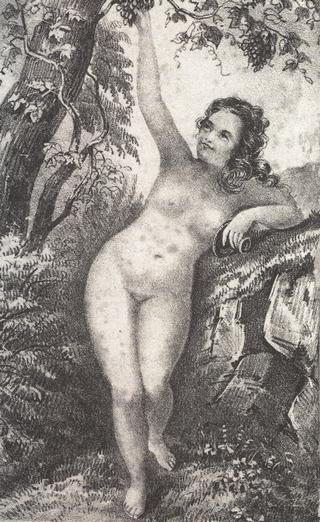Licentious Gotham
It’s a depressing fact for anyone who works with erotic materials that one’s historical record is a good deal thinner than it is for other scholars and artists. A long history of social stigma and legal repression has meant that much of the visual and literary record of the erotic past has been lost: at worst burned or buried in a landfill, at best stuck deep in some dead-tree archive, kept under lock and key by its curators. We owe gratitude, therefore, to those intrepid scholars who are at least able to get into the archives and haul forth what’s there for more general view.
One such intrepid scholar is Donna Dennis, Professor of Law and Frederick W. Hall Scholar at Rutgers Law School-Newark whose just-published Licentious Gotham: Erotic Publishing and Its Prosecution in Nineteenth-Century New York opens up the archives for the rest of us, and tells a pretty fascinating story besides. (I give a hat tip to Nick Gillespie, whose review inspired me to read it for myself and review it for ErosBlog.
It will come as no surprise to readers of ErosBlog that early nineteenth-century Americans had as healthy an appetite for spicy stories and naughty images as anyone else since our Pleistocene ancestors sat around campfires and painted on cave walls. And it’s no surprise also that the most commercial of American cities produced an extraordinary group of entrepreneurs able and willing to feed that appetite. Professor Dennis gives us back some of their names and also much of the cleverness with which they combated a legal regime that grew steadily more hostile to the publication of erotic materials. Professor Dennis restores to life characters like William Snelling, George Wilkes, and George Wooldridge, who pioneered the publication of what were then called “flash weeklies,” basically newspapers that published scandal news, including whatever racy details their reporters could dig up. When hauled into court on charges of obscene libel, they would cheekily declare that such publication was necessary to protect public morality: how else, they would argue, are we to protect New Yorkers against the depredations of its immoral elites, save by the threat of public exposure? The flash weeklies would also provide guides to the erotic underworld, including biographies of prostitutes, complete with their places of work, descriptions of their physical attributes, and sometimes even accounts of the services they offer. This could be justified as a means of allowing people to “avoid” them.
Of course, no history of erotic publishing would be complete without the occasional naughty image of its own, and Professor Dennis does provide a few rather interesting ones, e.g.:

Ironically, that rather appealing image is one of a few that adorn a book called The Secret Habits of the Female Sex by “Jean Dubois, M.D.”, which in fact was devoted to propounding a popular bit of nineteenth-century pseudoscience, to wit the view that masturbation would make you go blind, insane, feebleminded, etc. Then as now, sex was what sold.
But probably the greatest hero entrepreneur among antebellum New York pornographers would have been the legendary publisher George Akarman. The late twentieth century brought us the Internet, which clearly is for porn. Our Victorian antecedents didn’t have an Internet, but they did have the U.S. Post Office, which was the Internet of its day. Well before the Civil War, Akarman realized that by sending his naughty books through the mail, he could (1) evade local law and law enforcement and (2) dramatically expand his market beyond the New York area. And so, more than a generation before Richard Sears and Alvah Roebuck sent out the first number of their famous catalog, a New York pornographer was in the process of creating what must have been one of the world’s first mail-order businesses. More evidence, as if any more is really needed, that porn is an engine of progress.
But Akarman didn’t confine his attention just to distribution. In 1856 he also created Venus’ Miscellany, possibly the first erotic magazine in the United States. A prominent feature of this publication was a letters column, and this column provided what is possibly the biggest historical surprise in Professor Dennis’s book: letters, putatively from respectable middle-class women, celebrating female sexual adventure and autonomy. A very different vision than we usually receive of Victorian womanhood, or even of Victorian pornography. “Though one strongly suspects that Akarman was the author of these confessions,” Professor Dennis notes, “his emphasis on first-person female narrations of erotic desire and his affirmation of women’s right to sexual satisfaction are bracing, nonetheless.”
Thanks to the efforts of Akarman and his fellow entrepreneurs, Professor Dennis is able to report, soldiers fighting for the Union were well-diverted by mail-order erotic materials during the Civil War. (So porn played a role in ending slavery, too? Sweet!)
Unfortunately for the industry, one of these soldiers was a young Anthony Comstock, an individual for whom the term “pokenose” might have been invented. Doubtless suffering from the haunting fear that someone, somewhere might be happy and possibly also annoyed that racy materials were more interesting to his fellow troops than the Bible study sessions he was attempting to lead, Comstock devoted his life to becoming an anti-porn crusader.
And a most effective one he was, as Professor Dennis also shows. By 1873 Comstock had gotten an Act of Congress named after himself forbidding the use of the U.S. mails to “obscene” material (which of course included not just racy material but also bona fide medical information on sexual health and contraception) and gotten himself appointed a postal inspector, from which role he acted as the Nation’s Censor-in-Chief. And Comstock too was a pioneer, of law-enforcement techniques that would become all too common in Prohibition and the War on Drugs: questionable testimony from informants, possibly planted evidence, and actions that look suspiciously like entrapment. He and his fellows managed to seize and destroy a lot of material. He was so successful in his zeal that, as Professor Dennis notes (sadly, to my mind) that erotic materials from late nineteenth-century America are difficult to find, even in private archives.
Professor Dennis gives us yet another act of historical memory, a fine and poignant one, in retelling the story of one more individual, Elena del Varto, an impoverished widow entrapped by one of Comstock’s henchmen into posing for some naughty pictures. Though in frail health and having a child to support, she was sent to prison for a year. Whatever one thinks about porn, one cannot but shed a generous tear for Mrs. del Varto and reflect on what it tells us about the “morals” of the anti-porn crew, then as now.
An excellent read, as legal history, inspiring narrative, and cautionary tale. Highly recommended.
Shorter URL for sharing: https://www.erosblog.com/?p=3270








Ah ! The sears catalog of the 60’s; I would go trough the lingerie pages, dreaming of well guirdled bodies and seethrough negliges . In a sense, my two boys have it far too easy today; the internet has killed a certain aspect of eroticism . I, by accident, intercepted a e-mail from my eldest(16), asking one girfriend to dress like a slut, for him, when they would go out . I wonder if mr. Comstock raised a few boys ???
Good review faustus,
In my own research I’ve been looking at sexuality in prehistoric civilisations. As you wrote above, this sort of thing is hard to find concrete evidence for.
What I’ve read lately usually interprets women’s sexuality as being suppressed as an overall circumstance of the male power dynamic, etc. etc. From above I would interpret the male power dynamic as being shored up by the *sshole power dynamic. Hrm, I should pick up a copy of this.
Pal xxoo